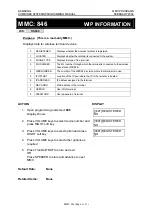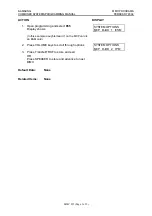
SAMSUNG
MMC PROGRAMS
COMBINED SYSTEMS PROGRAMMING MANUAL
FEBRUARY 2004
MMC 851 (Page 1 of 5)
MMC: 851
ALARM REPORT
FOR:
i
DCS100
i
DCS500
OS500
(
i
DCS systems must have a LAN interface installed.)
Purpose:
Views, stores, prints or clears system alarms. Two levels of faults are dis-
played: major alarms and minor alarms. Major alarms are usually service-affecting and
require a certified technician to determine the fault. A minor alarm indicates a fault that
may or may not be service-affecting and usually does not seriously degrade the system’s
operating capabilities. The alarm buffer will hold up to 100 alarms on a first in/first out
(FIFO) basis.
Alarms provide a date and time stamp based on the system time. If applicable, the hard-
ware cabinet, port, and/or slot will be displayed. If an ALARM I/O port is programmed in
, alarm information can be printed on demand and also as alarm information is
provided.
ALARM REPORTING OPTIONS
VIEW ALARM:
View alarm buffer (see
– OVERWRITTEN:
When buffer is full, the oldest entry in buffer
overwritten.
OVERFLOW
CONTROL:
– STOP RECORDING:
When buffer is full, stop recording alarms.
CLEAR ALARM BUF:
Clears alarm buffer.
PRINT ALARM BUF:
Prints contents of alarm
buffer to the assigned
alarm I/O port.
Procedure to View Alarms
ACTION
DISPLAY
1. Open programming and select
851
Display shows
SYS ALARM REPORT
VIEW ALARMS
2. Press VOLUME keys to select option (e.g. VIEW
ALARMS)
[00] 10/23 12:27
MJC14 C1–S10
3. Press VOLUME keys to select alarm e.g. 01
Displays date and time
(C=cabinet S=slot P=port)
[01] 10/23 12:27
MJC14 C1–S10
4. Press Transfer/TRSF to store and exit
OR
Press SPEAKER to store and advance to next
MMC






























